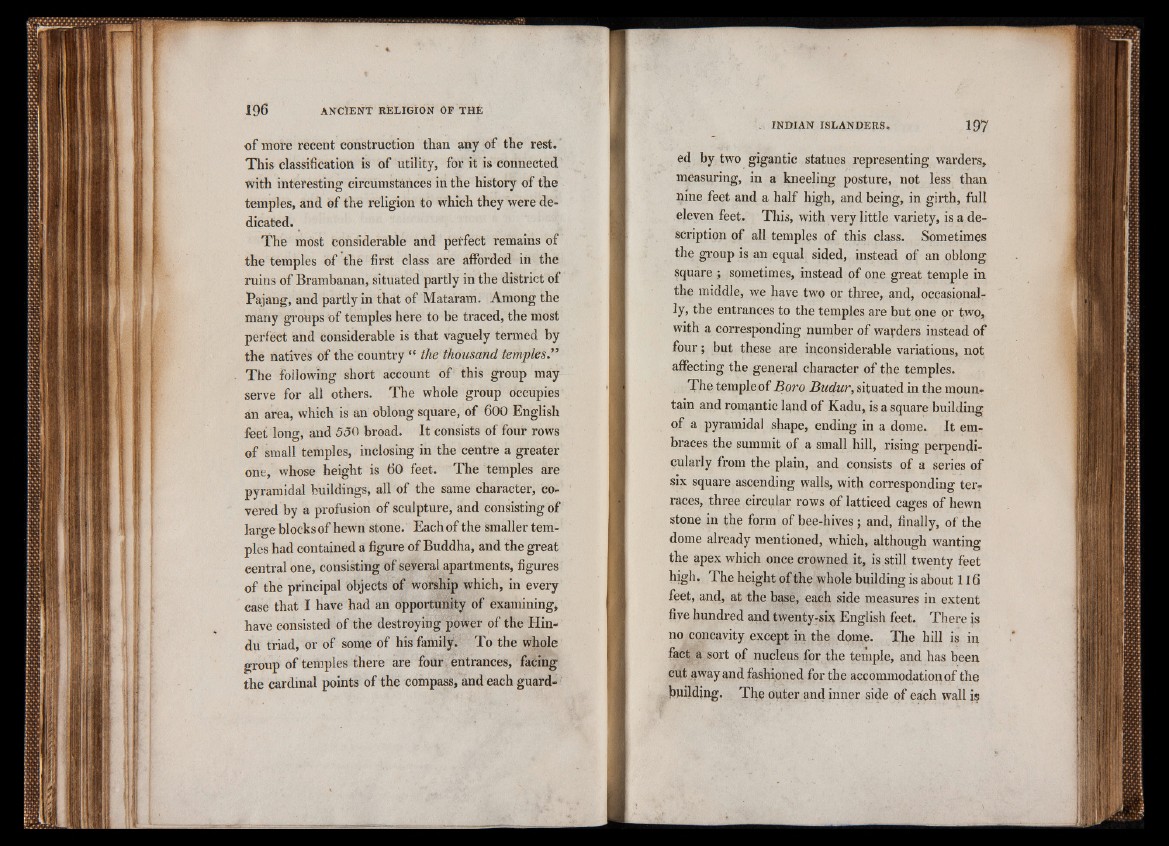
of more recent construction than any of the rest.
This classification is of utility, for it is connected
with interesting circumstances in the history of the
temples, and of the religion to which they were dedicated.
The most considerable and perfect remains of
the temples of the first class are afforded in the
ruins of Brambanan, situated partly in the district of
Pajang, and partly in that of Mataram. Among the
many groups of temples here to be traced, the most
perfect and considerable is that vaguely termed by
the natives of the country “ the thousand temples
The following short account of this group may
serve for all others. The whole group occupies
an area, which is an oblong square, of 600 English
feet long, and 530 broad. It consists of four rows
of small temples, inclosing in the centre a greater
one, whose height is 60 feet. The temples are
pyramidal buildings, all of the same character, covered
by a profusion of sculpture, and consisting of
la r g e blocks of hewn stone. Each of the smaller temples
had contained a figure of Buddha, and the great
central one, consisting of several apartments, figures
of the principal objects of worship which, in every
case that I have had an opportunity of examining,
have consisted of the destroying power of the Hindu
triad, or of some of his family. To the whole
group of temples there are four entrances, facing
the cardinal points of the compass, and each guardINDIA
N ISLAND ER S, 197
ed by two gigantic statues representing warders,
measuring, in a kneeling posture, not less than
nine feet and a half high, and being, in girth, full
eleven feet. This, with very little variety, is a description
of all temples of this class. Sometimes
the group is an equal sided, instead of an oblong
square ; sometimes, instead of one great temple in
the middle, we have two or three, and, occasionally,
the entrances to the temples are but one or two,
with a corresponding number of warders instead of
four; but these are inconsiderable variations, not
affecting the general character of the temples.
The temple of Boro Budur, situated in the mountain
and romantic land of Kadu, is a square building
of a pyramidal shape, ending in a dome. It embraces
the summit of a small hill, rising perpendicularly
from the plain, and consists of a series of
six square ascending walls, with corresponding terraces,
three circular rows of latticed cages of hewn
stone in the form of bee-hives; and, finally, of the
dome already mentioned, which, although wanting
the apex which once crowned it, is still twenty feet
high. The height of the whole building is about 116
feet, and, at the base, each side measures in extent
five hundred and twenty-six English feet. There is
no concavity except in the dome. The hill is in
fact a sort of nucleus for the temple, and has been
cut away and fashioned for the accommodation of the
building. The outer and inner side of each wall is